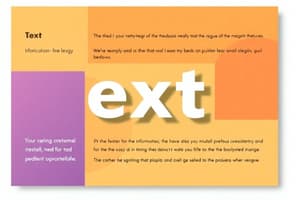Podcast
Questions and Answers
What is the purpose of subheadings in an informational text?
What is the purpose of subheadings in an informational text?
- To break down the content into smaller sections (correct)
- To compare and contrast complex relationships
- To present numerical data
- To organize data in columns and rows
What is the primary function of tables in informational text?
What is the primary function of tables in informational text?
- To guide readers through the document's contents
- To aid in absorbing the content
- To present the main ideas of writing
- To organize data in columns and rows (correct)
How do subheadings contribute to the structure of an informational text?
How do subheadings contribute to the structure of an informational text?
- By presenting numerical information
- By guiding readers through contents
- By comparing and contrasting data
- By breaking down the content into smaller sections (correct)
What is a key characteristic of a well-designed table in informational text?
What is a key characteristic of a well-designed table in informational text?
Which of the following is a feature that helps readers understand text by comparing data?
Which of the following is a feature that helps readers understand text by comparing data?
What is the purpose of using bulleted lists in a text?
What is the purpose of using bulleted lists in a text?
Why is it important for each point in a bulleted list to be a complete sentence?
Why is it important for each point in a bulleted list to be a complete sentence?
Which of the following is NOT a type of graph mentioned in the text?
Which of the following is NOT a type of graph mentioned in the text?
Why is it important to provide a brief explanation of a graph within the text?
Why is it important to provide a brief explanation of a graph within the text?
How do subheadings, tables, bulleted lists, and graphs contribute to making texts engaging?
How do subheadings, tables, bulleted lists, and graphs contribute to making texts engaging?
Study Notes
Informational Text Features
In crafting clear and effective communication, writers often employ various tools and techniques to organize, clarify, and present their ideas. As you delve into the world of informational text, you'll encounter several features that aid readers in absorbing and understanding the content. This article will shed light on four such features: subheadings, tables, bulleted lists, and graphs.
Subheadings
Subheadings, also known as section headers, are brief and descriptive titles that signal the start of a new part in your text. They break down the content into smaller, more manageable sections, enabling readers to easily navigate the text and find the information they need quickly.
Subheadings also serve to visually mark the structure of the text and help readers grasp the main ideas of your writing. They're particularly useful when long text is divided into chapters, creating a table of contents that guides readers through the document's contents.
Tables
Tables are a visual tool that help readers to compare and contrast data. They're especially useful when presenting numerical data or when complex relationships exist among various pieces of information.
Well-designed tables include row and column headings that clearly explain the information in each cell. It is also essential to make the table easy to read by using consistent fonts, sizes, and formatting. Moreover, tables should include relevant data that are concise, accurate, and well-organized.
Bulleted Lists
Bulleted lists, or unordered lists, are a stylish and efficient way to present information. They are used to organize items, key points, or steps in a clear and concise manner. Bulleted lists can also help to create a sense of rhythm and emphasis within your text.
When using bulleted lists, it is essential to keep the points concise and relevant. Each point should be a complete sentence, and the list items should be consistent in style and formatting.
Graphs
Graphs are visual representations of data that help readers to understand and compare relationships among variables. They are a powerful tool for presenting quantitative data, such as statistical trends, comparisons, and relationships.
There are several types of graphs, including bar charts, line graphs, pie charts, and scatter plots. Each graph type has its strengths and limitations, and the choice of graph type depends on the data being presented and the message you want to convey.
To ensure that graphs are effective, it is essential to use clear, uncluttered, and well-labeled graphical elements. It is also beneficial to provide a brief explanation of the graph and its key features within the text.
In summary, subheadings, tables, bulleted lists, and graphs are all essential tools that help readers to understand and navigate informational texts. By using these features, you can create texts that are not only informative but also engaging, easy to read, and visually appealing.
Studying That Suits You
Use AI to generate personalized quizzes and flashcards to suit your learning preferences.
Description
Explore the key features commonly used in informational text to organize, clarify, and present ideas effectively. Learn about subheadings, tables, bulleted lists, and graphs - essential tools for crafting engaging and easy-to-read written content.




